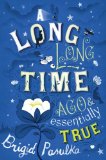
A Long, Long Time Ago… And Essentially True is a novel about
love, loss, and sacrifice. The book tells the stories of two generations of the
Mrozek family, with chapters alternating between the grandparents' experience
during WWII and the years immediately thereafter, and their granddaughter's life
in mid-1990s Krakow. First-time author Brigid Pasulka skillfully compares and
contrasts life in Poland during these two very different eras in the nation's
history, painting a vivid image of both its past and its present.
The episodes that concern Pigeon and Anielica ("Angel") have an
almost fairy-tale feel to them, in spite of the increasingly serious subject
matter. The time frame feels distant and slightly unreal, with Pigeon in
particular being a larger-than-life figure, always in control and capable of
overcoming any obstacle. The narrator of these sections tells their story with
warmth and humor.
The other residents of Half-Village observed the curious non-courtship with intense interest, and opinion polls were taken daily. Although results were subject to fluctuation, on average about five out of the twenty-seven other residents of Half-Village thought that the Pigeon did not talk because he had been stunned into silence by Anielica's beauty up close. Five thought that he was a coward, that he did not have the eggs to speak to her and had done all the work for nothing. Sixteen thought that he was an idiot and the only language he could speak was the language of work…Which brings up the theory of the twenty-seventh resident of Half-Village, that the Pigeon was not after Anielica's attentions at all, but Wladyslaw Jagiello's [Anielica's brother], and at that he had succeeded from the very first day. It was a bold position to take because everyone knows that Poland did not have air-conditioning, homeless people, good Mexican food, or homosexuals until after the communists left.
The parts of the book set in the latter half of the 20th
century are narrated by Beata, Pigeon and Anielica's granddaughter. Her first
person account depicts a woman whose life is more or less on hold. While her
circumstances are less dire than those of her grandparents, her story is darker
and lacks the joie de vivre evident in her grandparents' lives. Gone is
the storybook atmosphere, replaced by a mundane day-to-day existence. These
sections offer a counterpoint to those that center on Beata's grandparents,
helping to balance the folk tale with reality and preventing either style from
overpowering the novel.
Pasulka does a wonderful job forming her characters; they're at
once familiar and unique. Readers will feel they know someone exactly
like each of the people described, and yet they do not slip into stereotype,
instead they grow and change throughout the
novel, which is one of the elements that makes this book so appealing.
The only aspect that detracts somewhat is Pasulka's frequent use of Polish words, phrases and events without context. Sometimes
readers will be able to get the gist of a sentence's meaning, but other times
they'll be left in the dark. The intent may have been to provide
a deeper sense of place, but for the most part it seems unnecessarily confusing;
readers who find it annoying to pass over a word without understanding it might
find it helpful to reference a Polish-English translation
website from time to time.
A Long, Long Time Ago… And Essentially True packs a huge
emotional punch, particularly toward the end as the two story lines converge.
Pasulka shows her skill in these delicate sections with narrative that is
touching without being melodramatic.
This is a novel that will likely appeal to a wide range of
readers; and those who enjoy historical fiction, have a particular interest in
Poland, or who simply take pleasure in top-notch
writing will certainly want to put it high on their reading list.
![]() This review was originally published in October 2009, and has been updated for the
May 2010 paperback release.
Click here to go to this issue.
This review was originally published in October 2009, and has been updated for the
May 2010 paperback release.
Click here to go to this issue.
In A Long, Long Time Ago…And Essentially True, one of the
main characters, Beata, is constantly referred to by the nickname "Baba Yaga."
Baba Yaga is a popular figure in Slavic folk tales (Slavic
language map). Also known as the "Old Woman
of Autumn," her origins can be traced back to the ancient Slavic goddesses of birth
and death. The derivation of her name is not clear: "baba," is an abbreviated form
of the word "babushka," the Slavic term for an old woman or grandmother;
but the origins of "Yaga," are more muddy - possibly it is a corruption of "yagat" (to abuse or find fault), possibly it is from a Proto-Slavic word meaning lazybones, or it could simply be a diminutive of the Slavic name Jadwiga (a Polish variation of the German name Hedwig).


![]() This review was originally published in October 2009, and has been updated for the
May 2010 paperback release.
Click here to go to this issue.
This review was originally published in October 2009, and has been updated for the
May 2010 paperback release.
Click here to go to this issue.
Your guide toexceptional books
BookBrowse seeks out and recommends the best in contemporary fiction and nonfiction—books that not only engage and entertain but also deepen our understanding of ourselves and the world around us.